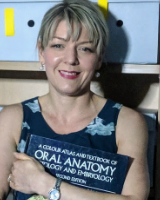Melbourne Femur Research Collection Group
-
Head of Section

Dr Rita Hardiman
Research Overview
RrrrThe Melbourne Femur Research Collection group focuses on research in bone biology from a medical, fundamental science and anthropological perspective. The collection comprises over 600 items, including samples of femoral bone, CT/microCT/PQCT scans, microradiographs and associated data.Currently, the collection supports a diverse range of research projects internationally. To learn more about the collection and how to access it, please visit our online Melbourne Femur Research Collection.
CURRENT PROJECTS
Bone metabolism and lifestyle in modern Australian bone from forensic contexts.
This project aims to collect and analyse quantitative histology data from modern Australian human femur microradiographs. These data will be used to 1) reconstruct bone remodelling relationships to categories of lifestyle, and 2) compare with bone remodelling data from medieval English individuals (who derive from an osteological collection curated at the University of Kent, UK). This project tests whether bone remodelling has slowed down with lifestyle change over the course of our recent history, and how bone in modern Australians responds to different lifestyle factors. The final step will be then to use these findings in explaining bone health trends in various archaeological Asia-Pacific populations. Preliminary results suggest the MFRC samples to have developed with lower biomechanical input and experienced less remodelling than the medieval samples. This project is part of an ARC DECRA (2019-2022) awarded to Dr Justyna Miszkiewicz at the ANU, and also involves a collaboration with researchers at the University of Kent, UK; and The George Institute for Global Health in Sydney.
Primary Investigator: Dr Justyna Miszkiewicz, Australian National University
Collaborators: Dr Rita Hardiman.
Sex determination in unknown human remains using dimorphism in femoral head volume.
Sex determination is an important aspect of identifying unknown human remains. Studies on skeletal collections have shown that femoral head diameter may be a useful determinant of sex in humans. This project involves developing a technique to define landmarks and develop volumetric measurement of the human femoral head. The results will then be used to test whether this is an effective method of determining an individual’s sex. This project is available at Masters level.
Primary Investigator/Supervisor: Dr Rita Hardiman
What is the origin of tetracycline-like staining in a sample of contemporary human femoral cortical bone?
The Melbourne Femur Research Collection is a well-documented sample of modern femoral bones. A number of years ago, research into the collection brought up a serendipitous finding of fluorescent staining in quite a high proportion of the collection. The staining, which was found in 73% of bones investigated, is characteristic of tetracycline compounds. The extent and severity of the staining raised a number of questions as to its origin and cause. Tetracycline is a broad-spectrum antibiotic, but is not recommended for use in those under eight years of age. This is because tetracycline accumulates in the mineralising regions of bones and teeth, and use in those under eight years of age can lead to visible discoloration of teeth.
This project will involve investigative techniques such as mass spectrometry to determine the exact cause of the fluorescence (thought to be tetracycline) within the bone tissue of the Melbourne Femur Research Collection, and will aim to determine the origin of the substance incorporated into the growing bone tissue.
There are many questions still to be answered about this finding: Is the staining actually caused by tetracycline? If it is tetracycline, what is the origin- therapeutic, or some other source? Is this result unique in this collection, or does it exist in other skeletal collections in Australia or the rest of the world?
This project is available at Masters level.
Primary Investigator/Supervisor: Dr Rita Hardiman
Co-supervisor/Investigator: Dr Louise Shewan
Staff
Research Projects
For project inquiries, contact our research group head.
Faculty Research Themes
School Research Themes
Forensic Bone Biology, Dental Materials
Key Contact
For further information about this research, please contact Head of Section Dr Rita Hardiman
Department / Centre
Unit / Centre
Melbourne Femur Research Collection Group
MDHS Research library
Explore by researcher, school, project or topic.